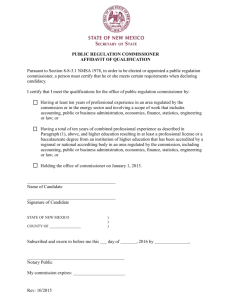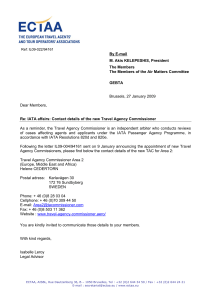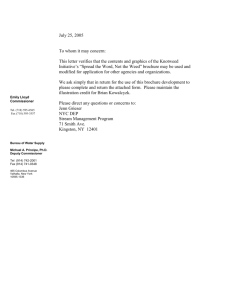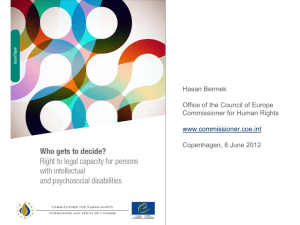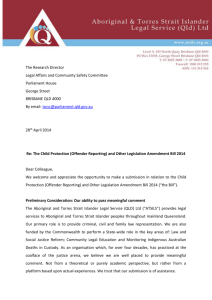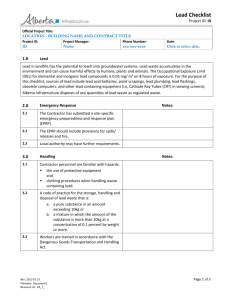Management of Oubreaks - West Virginia Department of Health and
advertisement
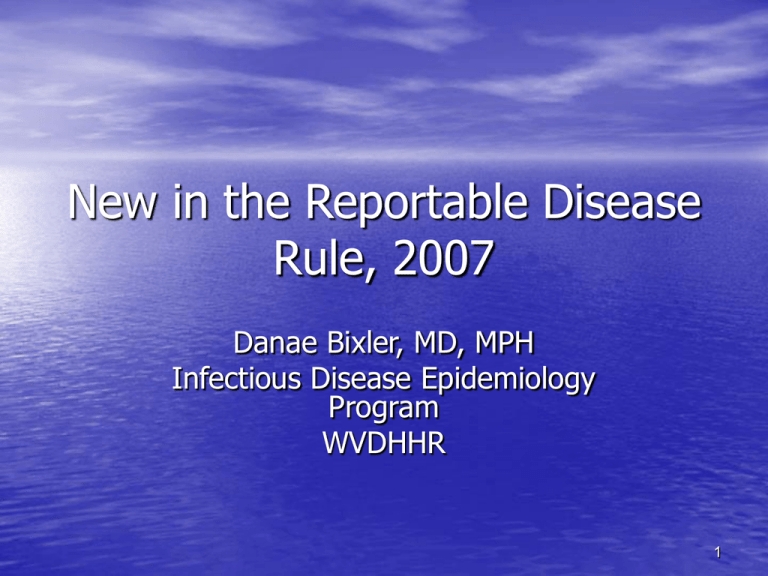
New in the Reportable Disease Rule, 2007 Danae Bixler, MD, MPH Infectious Disease Epidemiology Program WVDHHR 1 Objectives • Outline: – Timeline – Changes in rule: • Reporting timeframes • New diseases to be reported • Diseases that are no longer reportable • New sections that impact public health practice – Common issues that CAN be solved by application to the rule – Strengths and limitations of the rule 2 Timeline • Revision began 2003-4 – Internal review / drafting 2003-4 – Statewide comment 2004 • Legislative session 2005 – Rejected because of fiscal note • Second attempt 2005-6 – Statewide comment: 2005 – Legislative approval 2006 – Final copy received August 2006 3 Timeline (2) • Outstanding issues – Reporting of novel influenza – Further cleanup: • Eliminate reporting of occupational health • Name change to Shigatoxin-producing E coli • Eliminate provider reporting of chronic hepatitis C – Final version received March 5, 2007 4 Definitions • Local Health Officer = Local health officer or designee • Commissioner = Commissioner or designee 5 General Changes • Five categories of reportable conditions: – – – – – Immediate 24 hours 72 hours Weekly to LHD Weekly to state • Local health departments must report to state in the • same timeframe as providers Electronic reporting mandated from local health departments when the commissioner declares WVEDSS operational – anticipated July 2, 2007. 6 Selected Diseases Reportable Immediately to Local Health Category I • Category A BT agents – – – – – – Anthrax Botulism Plague Smallpox Tularemia Viral Hemorrhagic Fever • Novel influenza infection • Outbreaks • Measles and SARS 7 Figure 1 Outbreaks Reported and Investigated in West Virginia, 2001 - 2006 80 73 Number of Outbreaks 70 60 50 40 28 30 18 20 10 26 13 7 0 2001 2002 2003 2004 2005 2006 Year of Report 8 Immediately Reportable Events – Provider Responsibilities • Immediately report by phone to the local health department • Include: – Patient name, address, telephone number, date of birth, sex, race – Physician name, address, office phone and fax – Any other information requested by the commissioner 9 Immediately Reportable Events – Laboratory Responsibilities • Immediately report by phone to the local health • department Include: – Patient name, address, telephone number, date of birth, sex, race – Physician name, address, office phone and fax – Name of submitter – Specimen source, date of collection, date of result, name of test, test result, normal value or range – Laboratory name, address, phone and fax 10 Immediately Reportable Events – Local Health Department Responsibilities • Immediately report by phone to DHHR: 800-423-1271 • File a WVEDSS report – Required July 2, 2007 • See 64-7-7 (outbreaks) 11 Selected Diseases Reportable at 24 Hours to Local Health Category II • Animal bites • Hepatitis A, B • Meningitis (meningococcus, H flu) • Pertussis • Staphylococcus aureus resistant to Vancomycin • STEC (Enterohemorrhagic E coli) • Tuberculosis 12 Selected Diseases Reportable at 72 Hours to Local Health Category III • • • • • • • • • • Amebiasis Campylobacteriosis Cryptosporidosis Cyclospora Giardiasis Listeriosis Salmonellosis Shigellosis Trichinosis Yersiniosis 13 Selected Diseases Reportable at 1 Week to Local Health Category IV • • • • • • • • • • Arboviral infection Chickenpox (aggregate total only) Community-acquired MRSA (invasive) Death from chickenpox Influenza-like illness (aggregate only) Influenza-related death (age < 18) Legionellosis Lyme disease Invasive bacterial diseases (S pneumo, GAS, GBS) Tuberculosis latent infection 14 Selected Diseases Reportable at 1 Week to State Health Category V • • • • • AIDS Chancroid Chlamydia Gonococcal disease Hepatitis C – Providers – acute – Laboratories – all positive test results • PID • Syphilis 15 Eliminated • Aseptic meningitis • Bacterial meningitis, other • Encephalitis, other • Hepatitis C, chronic (from providers) • Herpes • Occupational illness • Rheumatic Fever 16 Added! Disease Timeframe Bioterrorist event Immediate Novel influenza infection, animal or human SARS coronavirus infection Immediate Unusual condition or emerging infectious disease of potential public health significance 24 hours Immediate 17 Added (2) Disease Timeframe Community-acquired invasive MRSA Death from chickenpox 1 week Death from influenza (age < 18) 1 week Laboratories only: enterovirus, culture confirmed, aggregate totals 1 week to state health dept 1 week 18 Rabies (64-7-5) • Animal bites reportable to the local health • • department within 24 hours Ferret added to list of animals that may be quarantined. Language added to: – Allow humane destruction of animals other than a domestic dog, cat or ferret, ‘especially a wild mammal or hybrid…’ – Enable reporting of rabies post-exposure prophylaxis to WVEDSS 19 Immunizations (64-7-6) • Reporting requirements expanded to persons 18 years of age and younger • Newly reportable – Smallpox vaccination – Pandemic influenza vaccination – Immunizations of adults (voluntary) 20 Disease outbreaks (64-7-7) • Immediate notification of: – Local health officer – The Bureau • Collaboration with – The Bureau – Other jurisdictions – Federal public health officials • Steps in investigation outlined • Enabling language to complete special studies (e.g., case-control, cohort), hold individually identifying data confidential 21 Surveillance program evaluation and special studies (64-7-8) • Commissioner given the ability to do evaluation of surveillance systems or special studies, including: – Right to request medical or laboratory records to perform audits for completeness, accuracy and timeliness of reporting – Do special studies (e.g., case-control, cohort, crosssectional) on the health of the population for the purpose of quantifying the risk to the population or access to appropriate prevention and control services – Hold data confidential 22 Bioterrorism response (64-7-9) • Immediate notification • Definition • Collaboration with other local health officers, state and federal officials, law enforcement • Investigation as in outbreak investigation section 23 Syndromic surveillance and electronic laboratory reporting (64-7-10) • Commissioner may create a list of syndromes to be reported: – – – – – – – – Acute neurological illness Acute vomiting and/or diarrhea Death in the emergency room Febrile illness with flu-like symptoms Febrile illness with flu-like symptoms and rash Pneumonia Septicemia of unknown etiology Other syndromes as defined by the Commissioner 24 Syndromic surveillance and electronic laboratory reporting (64-7-10) • When certified as operational by the Commissioner, laboratories with automatic reporting capability will report positive results daily, including – Patient name, address, telephone number, date of birth, sex – Submitter – Specimen source, date of collection, date of result – Test name, result, normal value or range – Laboratory name, address, phone and fax 25 Syndromic surveillance and electronic laboratory reporting (64-7-10) • When certified … laboratories with automatic reporting capability will report … additional conditions including: – Adenovirus – Enterovirus – Influenza – RSV – Rotavirus 26 Submission of Laboratory Specimens to Office of Laboratory Services: Isolates (12.2.b.1) • Bacillus anthracis • Clostridium botulinum • Corynebacterium diphtheriae • Tularemia • Salmonella • Shigella • Campylobacter 27 Submission of Laboratory Specimens to Office of Laboratory Services: Isolates (12.2.b.1) (2) • • • • Listeria monocytogenes Suspect or confirmed ETEC Yersinia pestis From a sterile site: – N meningitidis – S pneumoniae – Haemophilus influenzae • Other isolates as determined by the Commissioner 28 Submission of Virological, serological, EM , molecular samples … (12.2.b.2.G) • LaCrosse, West Nile, Eastern equine, St Louis • • • • • • • encephalitis viruses Orthopox virus Poliomyelitis Rabies Rubella Rubeola SARS Other specimens as determined by the Commissioner – Novel influenza virus 29 FAQ # 1 ‘I’m not sure I have jurisdiction…’ • For local health departments, jurisdiction = – Your county • Schools, camps, vessels and department- operated health care facilities are required to: – Report …. 64-7-12.3.a.1 – Assist with investigation …. 64-7-12.3.a.2 – Follow methods of control … 64-7-12.3.a.2 30 FAQ # 2 ‘Dr. C wants written permission from the patient to report…’ • Pg 17: …Providers and … facilities … shall: – Report …. 64-7-12.1.a.1 – Assist … in … investigation 64-7-12.1.a.2 – Submit specimens … 64-7-12.1.a.3 • HIPAA letter – http://www.wvdhhr.org/idep/PDFs/IDEP/HIPP A_Letter_11-05.pdf 31 FAQ # 3 ‘… I need to rule out this case, but negative results aren’t reportable ….’ • … Providers and … facilities … shall – ‘assist the … local health officer in ruling out previously reported cases … by submitting copies of negative laboratory tests … 16-712.1.a.7 32 FAQ # 4 ‘ … Dr. B won’t help me with contact investigation …’ • Pg 17-18: Health care providers and … facilities … shall … – Assist … in any necessary contact investigation … 647-12.1.a.2 – … advise … the patient … members of the patient’s household and other patient contacts …64-7-12.1.a.4 – Follow a method of control specified by the commissioner in established protocols … 64-712.1.a.5 – Assist … the local health officer by promoting implementation of the control method … specified in the protocol … 64-7-12.1.a.6 33 FAQ # 5 “Dr. A won’t report.’ • If … a … provider,… facility, laboratory … failed • • to report … the local health officer … shall request an explanation …64-7-14.6 The local health officer shall report to the commissioner the … provider, … facility, laboratory … and his or her reason for failure to comply … 64-7-14.7 (Call us first) 34 FAQ # 6 ‘Attorney X is requesting a disease report – can I give it to him?’ • Pg 21: … the local health officer may release confidential information … to: – The patient 64-7-18.2.a – The patient’s physician …. 64-7-18.2.d – Any individual with the written consent of the patient and of all other individuals identified …64-7-18.2.e 35 Limitations • Isolation and quarantine – Operational plans require court orders • Owned dog, cat or ferret: – Only option: ‘… shall direct owner to confine …’ 64-7.5.3 • Keeping the rule up to date … Commissioner … – … may…add or delete a disease or condition … 64-7-3.1.a – … may require same day reporting … 36 Strengths of the Rule • Clear responsibilities for providers, laboratories, health officials, schools, vessels… – – – – – – – Reporting Investigating Outbreak investigation Contact investigation Surveillance evaluation and special studies Confidentiality Electronic reporting 37 Strengths of the Rule • Reportable Disease Protocol Manual – The commissioner shall establish specific protocols …64-7-3.2.a – … providers and … facilities … 64-7-12.1.a.5 – … laboratories …64-7-12.2.b.1 – … local health officers … 64-7-14.3.a and 64-7-14.3.b – … schools, camps, vessels, and department-operated health care facilities …. 64-7-12.3.a.3 38 Myth: ‘… I don’t have the authority to ...’ • 64-7-14 Responsibilities of Local Health Officers: – Comply with rule – Maintain records – Investigate/collect specimens/manage contacts/report to BPH • Reportable disease protocol manual • Consultation with the Commissioner – Investigate providers who don’t report 39 Always … advise appropriately and document… You (the local health officer) can have tremendous influence (authority) in your jurisdiction … 40 Conference Call on the Reportable Disease Rule and WVEDSS • WHO: Local Health Departments, Hospital Infection Control Professionals, Hospital Laboratory Directors • WHEN: Wednesday, May 30 and Friday, June 8, 2007; 12:00 to 1:30 PM • HOW: dial 1-888-819-5079; passcode = 586900 • CAUTION: Only 125 lines each call 41
